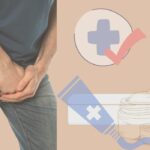Many years ago, in the bustling heart of my urology residency, I encountered a young man plagued by a problem that affected not just his physical well-being but his mental health too.
His confidence was being steadily eroded by an issue so common yet so rarely discussed: dry, cracked foreskin. This issue, though intimate and often embarrassing to discuss, is prevalent among men. My subsequent journey through the world of creams, ointments, and treatments led me to a treasure trove of solutions that I’m eager to share with you.
An Overview of the Issue
The Anatomy and Function of the Foreskin
The foreskin is an essential part of the male genital anatomy, primarily protecting the sensitive glans penis. The foreskin maintains optimal moisture levels and facilitates sexual functions. Its health is often a reflection of our overall wellness.
Sometimes, due to various factors, the foreskin can become dry and cracked, causing discomfort. Identifying these issues is the first step toward resolution. However, it is essential to consult a medical professional for proper diagnosis.
Causes of Dry Cracked Foreskin
The dry, cracked foreskin can be attributed to various factors. Here are some common causes:
- Lack of moisture: This could be due to frequent washing with harsh soaps, which strip the skin of its natural oils.
- Infections: Certain infections, like thrush or balanitis, can cause dryness and cracking.
- Dermatological conditions: Skin conditions such as psoriasis or eczema can affect the foreskin.
These causes are often treatable with appropriate interventions, including the use of specific creams.
Creams: The Essential Solution
The Role of Creams in Treatment

The topical application of creams plays a significant role in managing dry, cracked foreskin. These creams moisturize the skin, aid in the healing process, and sometimes combat infection.
Understanding how different creams work helps us select the most effective one for our needs. However, it’s important to remember that what works for one person might not work for another. Consultation with a healthcare provider is critical in this selection process.
Common Ingredients in Effective Creams
Common ingredients in these creams include:
- Emollients: These ingredients form a protective layer over the skin, preventing moisture loss. Examples include lanolin and petroleum jelly.
- Humectants: These draw water from the deeper skin layers and the atmosphere into the outermost skin layer. Glycerin is a common humectant.
- Keratolytics: These can help with severe dryness by aiding in the shedding of the outermost skin layer. Salicylic acid is a typical keratolytic.
Understanding these ingredients can help you select an effective cream.
The Best Creams for Dry Cracked Foreskin
Over-The-Counter Options

OTC creams can provide quick relief and easy accessibility. Two noteworthy options are:
- Eucerin Aquaphor Healing Ointment: This petroleum-based ointment is excellent for dry, cracked skin. It acts as an emollient, sealing in moisture.
- CeraVe Moisturizing Cream: This cream contains hyaluronic acid, a potent humectant, and ceramides, which help restore the skin’s protective barrier.
Remember to patch test any new cream before full application.
Prescription Creams
Prescription creams are often used when OTC options are ineffective or when an infection is present.
- Hydrocortisone creams: These are useful in managing inflammation and can be prescribed in various strengths.
- Antifungal creams: These are prescribed for yeast infections that could cause dryness and cracking.
It’s crucial to use these creams as directed by your healthcare provider.
Cream Application: Best Practices
When and How to Apply

The best time to apply these creams is after a bath or shower while the skin is still slightly damp. This helps lock in moisture. Apply the cream gently without causing further irritation to the skin.
It’s important to remember not to overuse these creams, especially prescription ones, as this can lead to side effects. Always follow the instructions provided.
Things to Avoid
Avoid harsh soaps and fragranced products, which can strip the skin of its natural oils. Steer clear of potential allergens in creams, such as perfumes or dyes, which could worsen the condition.
Never share your creams with others, even if their symptoms are similar. Each person’s condition may require a unique treatment.
When to Seek Professional Help
Symptoms to Watch For

If symptoms persist or worsen despite using creams, it’s time to consult a healthcare professional. Signs to watch out for include increased redness, swelling, pain, or the appearance of sores or discharge.
Early intervention can prevent complications and provide relief faster.
How a Urologist Can Help
A urologist or a dermatologist can provide a proper diagnosis and treatment plan. This may include stronger prescription creams or additional therapies, such as light therapy for certain skin conditions.
Don’t let embarrassment prevent you from seeking help. Remember, it’s their job to assist with these kinds of issues.
Additional Therapies and Lifestyle Adjustments
Complementary Therapies

Aside from using creams, some complementary therapies might aid in alleviating the symptoms of dry, cracked foreskin.
- Aloe Vera: Known for its soothing and anti-inflammatory properties, applying aloe vera gel can offer relief.
- Oatmeal Baths: Oats are known for their moisturizing and soothing properties, making oatmeal baths a great complement to your treatment.
Always ensure that you’re not allergic to these natural remedies before use.
Dietary Considerations
Your diet can also play a role in your skin’s health.
- Consuming a balanced diet rich in essential vitamins and minerals, such as vitamin E and zinc, can contribute to better skin health.
- Staying well-hydrated helps maintain skin moisture levels.
Always consult your healthcare provider before making significant dietary changes.
Prevention and Maintenance
Prevention Strategies

Prevention is always better than cure. Here are some strategies to prevent dry and cracked foreskin:
- Maintain Hygiene: Regularly and gently clean the area with warm water and mild soap.
- Moisturize: Regularly apply a suitable moisturizing cream or ointment.
- Stay Hydrated: Drink plenty of fluids to help maintain overall skin health.
Remember that these strategies are general guidelines, and individual requirements may vary.
Long-Term Skin Maintenance
Maintaining the health of your foreskin is an ongoing process. Regularly monitor the area for any changes, and continue to use suitable moisturizers even after the issue is resolved to prevent recurrence.
Lastly, regularly scheduled check-ups with your healthcare provider will ensure any recurring or new issues are promptly addressed.
The Psychological Aspect: Mental Health Matters
The Emotional Impact of Skin Conditions

The embarrassment and discomfort associated with skin conditions like dry, cracked foreskin can take a toll on your mental health. This is a vital aspect of the condition that often gets overlooked.
Please remember that you’re not alone in this journey. Don’t hesitate to seek professional help if you’re feeling stressed, anxious, or depressed.
Coping Mechanisms
Learning to cope with the emotional stress of skin conditions can greatly improve your overall well-being.
- Support Groups: Interacting with others facing similar issues can provide much-needed emotional support and useful tips.
- Meditation and Mindfulness: These techniques can help manage stress and anxiety.
- Professional Help: Therapists and psychologists can provide strategies to manage stress and improve mental well-being.
Remember, taking care of your mental health is just as important as addressing your physical symptoms.
Final Words
Managing dry cracked foreskin can significantly improve your quality of life. With the right cream and care, relief is just a dollop away. Don’t suffer in silence; there’s a whole world of treatments ready to help. Your path to comfort starts here.





